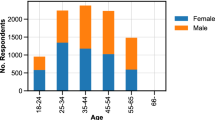Abstract
The tradeoff between employees’ workplace privacy and employers’ need to protect company assets, safeguard proprietary information, and avoid costly litigation has been receiving increased attention (Lee and Kleiner 2003; Mello 2003; National Workplace Institute 2004). This tradeoff often favors employers, as the legal system provides much leeway for employers to monitor employees’ electronic communications in the workplace. However, employers need to consider the effect such monitoring has on their employees since employee and employer attitudes about monitoring often diverge. In this article, we explore workplace email monitoring from both employee relations and legal perspectives and discuss implications for employee morale.
Similar content being viewed by others
References
Ambrose, M. L., & Cropanzano, R. (2003). A longitudinal analysis of organizational fairness: An examination of reactions to tenure and promotion decisions. Journal of Applied Psychology, 88(2), 266–275.
Booker v. GTE.NET LLC. (2003). 350 F. 3d 515 (6th Cir.).
Cal Const. Article I, Section 1.
Culnan, M., & Armstrong, P. K. (1999). Information privacy concerns, procedural fairness, and impersonal trust: An empirical investigation. Organization Science, 10, 104–116.
Eddy, E. R., Stone, D. L., & Stone-Romero, E. F. (1999). The effects of information management policies on reactions to human resource information systems: An integration of privacy and procedural justice perspectives. Personnel Psychology, 52(2), 335–359.
Electronic Communications Privacy Act of 1986 (2005). 18 U.S.C. Section 2510 et seq.
Electronic Monitoring and Surveillance Survey (2005). American Management Association and epolicy Institute Research. Retrieved from http://www.amanet.org/research/pdfs/EMS_summary05.pdf.
Esen, E. (2005). Workplace privacy poll findings. Alexandria, VA: Society for Human Resource Management.
Fishman, C. S. (2004). Surveillance, records and computers: Technology and the internet: The impending destruction of privacy by betrayers, grudgers, snoops, spammers, corporations, and the media. George Washington Law Review, 72, 1503–1555.
Gabel, J. T. A., & Mansfield, N. R. (2003). The information revolution and its impact on the employment relationship: An analysis of the cyberspace workplace. American Business Law Journal, 40, 301–351.
Hornung, M. S. (2005). Think before you type: A look at email privacy in the workplace. Fordham Journal of Corporate & Financial Law, 11(1), 115–160.
King, N. J. (2003). Labor law for managers of non-union employees in traditional and cyber workplaces. American Business Law Journal, 40(4), 827–883.
Lasprogata, G., King, N. J., & Pillay, S. (2004). Regulation of electronic monitoring: Identifying fundamental principles of employee privacy through a comparative study of data privacy legislation in the European Union, United States and Canada. Stanford Technology Law Review, 4. Retrieved from http://stlr.standford.edu/STLR/Articles/04_STLR_4.
Lee, S., & Kleiner, B. H. (2003). Electronic surveillance in the workplace. Management Research News, 26(4), 72–81.
Mastrangelo, P. M., & Popovich, P. M. (2000). Employees’ attitudes toward drug testing, perceptions of organizational climate, and withdrawal from the employer. Journal of Business and Psychology, 15(1), 3–18.
Mello, J. A. (2003). The evolving nature of the employment relationship: Reconsidering employee responsibilities and rights. Employee Responsibilities and Rights Journal, 15, 99–101.
Muick v. Glenayre electronics. (2002). 280 F.3d 741 (7th Cir.).
National Workplace Institute (2004). Report privacy under siege: Electronic monitoring in the workplace.
Pearce, J. A., & Kuhn, D. R. (2003). The legal limits of employees’ off-duty privacy rights. Organizational Dynamics, 32(4), 372.
Richer, S. F., Blanchard, C., & Vallerand, R. J. (2002). A motivational model of work turnover. Journal of Applied Social Psychology, 32(10), 2089–2113.
Rogers, A. (2000). You got mail but your employer does too: Electronic communication and privacy in the 21st century workplace. Journal of Technology and Law and Policy, 5, 1–9.
Smith, M. J., Carayon, P., Sanders, K. J., Lim, S. Y., & LeGrande, D. (1992). Employee stress and health complaints in jobs with and without electronic monitoring: Abstract. Applied Ergonomics, 23(1), 17–28.
Smith, A. D., & Faley, R. A. (2001). E-mail workplace privacy issues in an information and knowledge based environment. Southern Business Review, 27(1), 8–22.
Smyth v. Pillsbury Co. (1996). 914 F. Supp. 97 (E.D.Pa.).
Stanton, J. M. (2003). Effects of workplace monitoring policies on potential employment discrimination and organizational attractiveness for African Americans in the technical professions. Journal of Black Psychology, 29(3), 257–274.
Stone, E. F., & Stone, D. L. (1990). Effects of loss of privacy on physical and mental health. Paper presented at the Society for Industrial Organizational Psychology, Miami, FL.
Stoney, A. G., & Tompkins, P. K. (1997). Electronic performance monitoring: An organizational justice and concertive control perspective. Management Communication Quarterly, 10(3), 259–289.
Tabak, F., & Smith, W. P. (2005). Privacy and electronic monitoring in the workplace: A model of managerial cognition and relational trust development. Employee Responsibilities and Rights Journal, 17(3), 173–189.
Thygeson v. U.S. Bancorp. (2004). WL 2066746 (D. Or.).
Tolchinsky, P. D., McCuddy, M. K., Adams, J., Ganster, D. C., Woodman, R. W., & Fromkin, H. L. (1981). Employee perceptions of invasion of privacy: A field simulation experiment. Journal of Applied Psychology, 66(3), 308–314.
Wakefield, R. L. (2004). Computer monitoring and surveillance: Balancing privacy with security. The CPA Journal, 74(7), 52–55.
Warren, S. D., & Brandeis, L. D. (1890). The right to privacy. Harvard Law Review, 4(5), 193–220 (Dec. 15, 1890).
Zwieg, D., & Webster, J. (2002). Where is the line between benign and invasive? An examination of psychological barriers to the acceptance of awareness monitoring systems. Journal of Organizational Behavior, 23(5), 605–633.
Author information
Authors and Affiliations
Corresponding author
Rights and permissions
About this article
Cite this article
Friedman, B.A., Reed, L.J. Workplace Privacy: Employee Relations and Legal Implications of Monitoring Employee E-mail Use. Employ Respons Rights J 19, 75–83 (2007). https://doi.org/10.1007/s10672-007-9035-1
Published:
Issue Date:
DOI: https://doi.org/10.1007/s10672-007-9035-1




